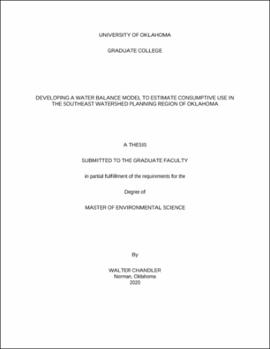| dc.contributor.advisor | Vogel, Jason | |
| dc.contributor.author | Chandler, Walter | |
| dc.date.accessioned | 2020-05-08T19:16:18Z | |
| dc.date.available | 2020-05-08T19:16:18Z | |
| dc.date.issued | 2020-05-08 | |
| dc.identifier.uri | https://hdl.handle.net/11244/324330 | |
| dc.description.abstract | With the passage of the Water for 2060 Act, Oklahoma established a statewide goal of consuming no more freshwater in 2060 than was consumed in 2012. However, there currently does not exist a quantifiable method to estimate consumptive water use in the long-term. A quantitative analysis of freshwater consumptive use in Oklahoma using a water balance approach would not only make it possible to gauge whether quantifiable water use goals are being met, but would also be useful for water resource managers across the state to track consumptive use and determine where and when conservation strategies may be implemented to have the most impact.
A water balance model (WBM) was developed to quantify consumptive water use at a Watershed Planning Region scale in Oklahoma. Under perfect natural conditions, the inflow and outflow water volumes in a region over a given period of time will be equal. However, humans disturb the natural conditions by removing water from the hydrologic cycle through consumptive use. Considering consumptive use as a component of the water balance, the volumes of each inflow and outflow component of the water balance were estimated, and consumptive use was estimated using a water balance equation as the residual imbalance caused by humans removing the water from the natural system. The WBM was developed for the Southeast Watershed Planning Region of Oklahoma (SEWPR) at a quarterly (3-month) temporal scale, with the goal of applying the model to other Watershed Planning Regions in the future.
The WBM results for quarterly consumptive use were unrealistically high and even negative in some cases. The likely cause of these extreme values is the large and mostly unknown uncertainty associated with the WBM component estimation methodologies. While the WBM is currently not suitable for consumptive use estimation, the gathered data, developed methodologies, and valuable information obtained from this research provide a useful framework for future research. | en_US |
| dc.language | en_US | en_US |
| dc.subject | water balance model | en_US |
| dc.subject | consumptive use | en_US |
| dc.subject | hydrology | en_US |
| dc.subject.lcsh | Water balance (Hydrology) | |
| dc.subject.lcsh | Hydrologic models | |
| dc.subject.lcsh | Water use--Oklahoma | |
| dc.subject.lcsh | Water-supply--Oklahoma | |
| dc.title | Developing a Water Balance Model to Estimate Consumptive Use in the Southeast Watershed Planning Region of Oklahoma | en_US |
| dc.contributor.committeeMember | Basara, Jeffery | |
| dc.contributor.committeeMember | Gourley, Jonathan | |
| dc.date.manuscript | 2020-05 | |
| dc.thesis.degree | Master of Environmental Science | en_US |
| ou.group | Gallogly College of Engineering::School of Civil Engineering and Environmental Science | en_US |
| shareok.orcid | 0000-0001-6068-8706 | en_US |
| shareok.nativefileaccess | restricted | en_US |
